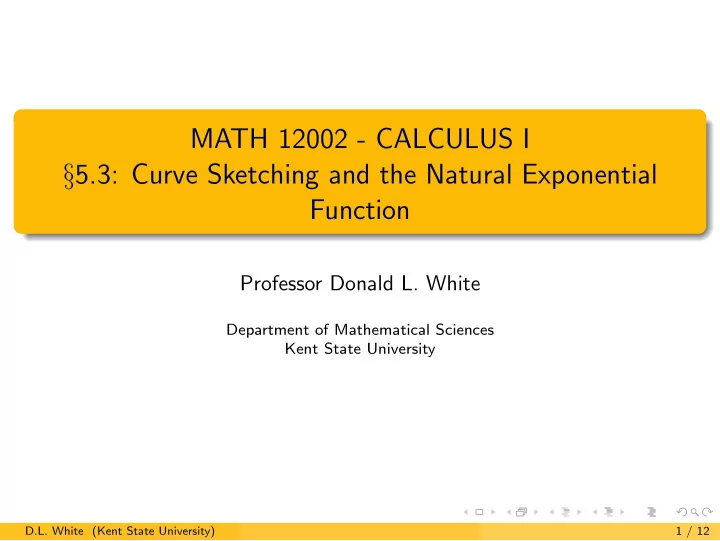

MATH 12002 - CALCULUS I § 5.3: Curve Sketching and the Natural Exponential Function Professor Donald L. White Department of Mathematical Sciences Kent State University D.L. White (Kent State University) 1 / 12
Example Example Let f ( x ) = x 2 e x . Determine intervals where f is increasing, intervals where f is decreasing, the location of all local maxima and minima, intervals where f is concave up, intervals where f is concave down, the location of all inflection points, and sketch the graph of f . D.L. White (Kent State University) 2 / 12
Example We need to determine the signs of f ′ and f ′′ for f ( x ) = x 2 e x . We have f ′ ( x ) = 2 xe x + x 2 e x = e x ( x 2 + 2 x ) = e x x ( x + 2) and f ′′ ( x ) = e x ( x 2 + 2 x ) + e x (2 x + 2) = e x ( x 2 + 4 x + 2) . Recall that e x is never 0 or negative. So f ′ ( x ) = 0 when x = 0 or x = − 2, and f ′′ ( x ) = 0 when x 2 + 4 x + 2 = 0. By the quadratic formula, this occurs when √ √ √ 4 2 − 4 · 1 · 2 √ x = − 4 ± = − 4 ± 8 = − 4 ± 2 2 = − 2 ± 2 . 2 2 2 √ √ Thus f ′′ ( x ) = 0 when x = − 2 − 2 ≈ − 3 . 4 or x = − 2 + 2 ≈ − 0 . 6, √ √ and f ′′ ( x ) = e x [ x − ( − 2 − 2)][ x − ( − 2 + 2)]. D.L. White (Kent State University) 3 / 12
Example √ √ f ( x ) = x 2 e x , f ′ ( x ) = e x x ( x + 2), f ′′ ( x ) = e x [ x − ( − 2 − 2)][ x − ( − 2 + 2)] √ √ − 2 − 2 − 2 − 2 + 2 0 e x + + + + + 0 − − − − + x 0 x + 2 − − + + + f ′ ( x ) 0 0 + + − − + ✛ e x + + + + + √ 0 x − ( − 2 − 2) − + + + + √ 0 x − ( − 2 + 2) − − − + + f ′′ ( x ) 0 0 ✲ + − − + + I I D D I Inc-Dec MAX MIN ✛ U D D U U Concave INF INF ✲ ✌ ✎ ☞✍ ✌ Shape D.L. White (Kent State University) 4 / 12
Example √ √ f ( x ) = x 2 e x , f ′ ( x ) = e x x ( x + 2), f ′′ ( x ) = e x [ x − ( − 2 − 2)][ x − ( − 2 + 2)] √ √ − 2 − 2 − 2 − 2 + 2 0 I I D D I Inc-Dec MAX MIN U D D U U Concave INF INF ✌ ✎ ☞✍ ✌ Shape f is increasing on ( −∞ , − 2) ∪ (0 , ∞ ), f is decreasing on ( − 2 , 0); f has a local maximum at x = − 2, f has a local minimum at x = 0. √ √ f is concave up on ( −∞ , − 2 − 2) ∪ ( − 2 + 2 , ∞ ), √ √ f is concave down on ( − 2 − 2 , − 2 + 2); √ √ f has inflection points at x = − 2 − 2 and x = − 2 + 2. D.L. White (Kent State University) 5 / 12
Example In order to sketch the graph of f , we will need to plot the points whose x coordinates are in the sign chart. We need to evaluate f ( x ) = x 2 e x at these points: √ √ √ 2 ≈ 0 . 38 2) 2 e − 2 − f ( − 2 − 2) = ( − 2 − ( − 2) 2 e − 2 = 4 f ( − 2) = e 2 ≈ 0 . 54 √ √ √ 2 ≈ 0 . 19 2) 2 e − 2+ f ( − 2 + 2) = ( − 2 + 0 2 e 0 = 0 f (0) = Note that (0 , 0) is the only x - or y -intercept, and f ( x ) = x 2 e x is positive for all other values of x . Also, x → + ∞ x 2 e x = + ∞ and x →−∞ x 2 e x = 0 lim lim (though we do not yet have the tools to verify the second limit). Hence y = 0 is a horizontal asymptote at −∞ . D.L. White (Kent State University) 6 / 12
Example D.L. White (Kent State University) 7 / 12
Example D.L. White (Kent State University) 8 / 12
Example D.L. White (Kent State University) 9 / 12
Example D.L. White (Kent State University) 10 / 12
Example D.L. White (Kent State University) 11 / 12
Example D.L. White (Kent State University) 12 / 12
Recommend
More recommend